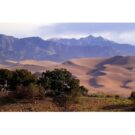Great Sand Dunes National Park and Preserve

by Sandra Merville Hart
Over 250,000 people visit Great Sand Dunes National Park and Preserve in Colorado every year. These sand dunes are the tallest in the United States.
Unusual surroundings
Unusual landscapes surround the impressive sand dunes. Guests find wetlands, snow-capped mountains, aspen forests, grasslands, and alpine lakes. They also see tundra, a treeless area of flat land where the ground is frozen.
Sandboarding and sand sledding
Slide down a 300-foot sand dune on a sandboard or sand sled, which are specifically made for sand. The sand can reach 150 degrees in summer, so plan to ride in early morning or evening in that hot season. Always wear shoes. Spring afternoons may be windy.
Sandboarding, skiing, and sledding are allowed on dunefields away from vegetation.
Splash in Medano Creek
Medano Creek attracts all ages. Located along the base of the sand dunes, everyone will love splashing around in the creek on a summer day.
Surges in the water create waves in the creek so watch for these “surge flows.”
Trail hiking
Explore the forest, alpine trails, grasslands, and wetlands. Hike up High Dune for a great view of the dunes, mountains, and San Luis Valley.
To reach the top of the sand dunes, zigzag up the dune instead of climbing straight up.
Wildlife in the park
Ptarmigan is a bird that looks like a chicken and can be found in the Grand Dunes tundra. Tourists may also find mule deer, chickadees, bighorn sheep, coyotes, and magpies.
Sources:
Flynn, Sarah Wassner. National Geographic Kids: National Parks Guide U.S.A., National Geographic Society, 2012.
“Great Sand Dunes,” National Park Service, 2016/01/09 http://www.nps.gov/grsa/index.htm.
McHugh, Erin. National Parks: A Kid’s Guide to America’s Parks, Monuments, and Landmarks, Black Dog & Leventhal Publishers, Inc., 2012.




